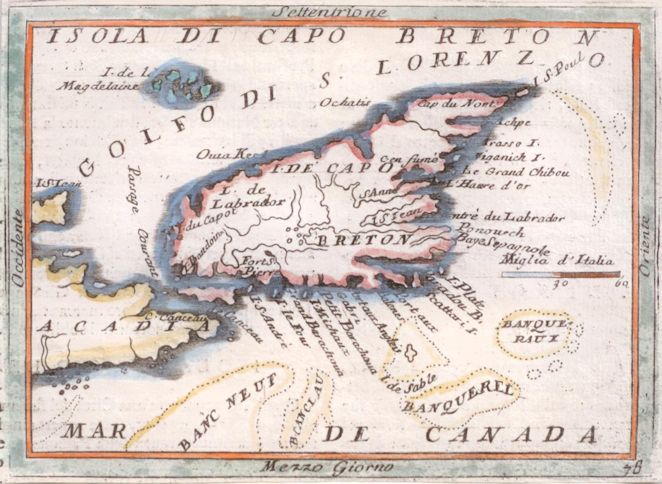The first Frenchman to try and establish a colony in northeast America was Étienne Bellinger. He was a general merchant in Rouen who by 1582 had been on at least two voyages to the Maritimes, visiting Cape Breton for trade and traveling down the coast of Nova Scotia. In 1583, Bellenger organized a mission to Cape Breton with Michael Costé as captain and pilot. The original plan was to explore the Maritimes and at a suitable location, drop off Bellinger and 20 men to establish a colony.
Bellenger and Costé left Le Havre on 19 January in the Chardon of 50 tons, carrying a small pinnace, and arrived only 20 days later. Bellenger then made a “thorough survey of the coast, west-southwestwards from the cape, charting bays and harbors, rocks and islands and sounding shallows and deeps. He explored the coasts southward from Cape Breton, coasted the southern shore of Nova Scotia, and then turned along its north coast into the Bay of Fundy, followed its limits around southern New Brunswick and, in the open sea again, some way along the coast of Maine, before turning homewards to France” (Quinn, 2003).
Bellenger set on land at least 10 or 12 times during his voyage to search for mineral wealth and trade with the local Innu. “In many places, he had traffic with people which are of very good disposition and stature of the body. They wear their hair hanging down long before and behind as low as their navels which they cut short only over their brows. They go all naked saving their privates which they cover with an Apron of some beast skin and tie it unto them with a long buff girdle that comes three times about them being made fast behind and at both the ends it is cut into little thin thongs, which thongs they tie round about them with slender quills of birds feathers whereof some are as red as if they had been dyed. Their girdles have also a little coil or Purse of buff wherein they put diverse things, but especially their tinder to keep fire in, which is of a dry root and somewhat like a hard sponge and will quickly take fire and is hardly put out. Their weapons whereof he brought home to show the Cardinal are bows yards long and arrows of one yard headed with indented three or fewer inches long and are tied into a knot at the with a thong of leather” (Marsh, 1962).
On one of his landings, near today’s Cap de Sable, Bellinger visited a large village of 80 houses, with a population of about 800, and traded some small merchandise for “elk, deer and seal skins along with marten, beaver, otter and lynx pelts, samples of castor, porcupine quills, dyestuffs, and some dried deer-flesh” (Quinn, 2003).
Most of his interactions with the local people were positive, but he had one very negative experience about 200 miles west of Cape Breton. The people there were “cruel and subtle of nature than the rest. And you are not to them but to stand upon your guard for among them he lost two his men and his small pinnace which happened through their folly in trusting the salvages too far.” (Marsh, 1962)
Quinn (1962) suggests that “The difference in hostility displayed by the Amerindians may have been due to previous contact with Europeans or it may represent a tribal boundary. If it was the former, it would not be surprising that contact with violent, drunken, fire-armed European fishermen and part-time fur traders should have rendered the Indians at least equally violent and, perhaps more treacherous. But the Micmac did not, universally, have a bad reputation amongst the whites. By April they would probably be back in their villages ready to trade their furs.”
It is possible that John Cabot visited Cape Breton in 1497, and European fishermen likely began landing in the territory in the early 1500s. In about 1521–22, the Portuguese João Álvares Fagundes established a fishing colony on the island at what is now known as Ingonish (Morison, 1971). It lasted there for a year to eighteen months until the settlers were forced to move by the locals. The colony’s subsequent fate is unknown.
In late May, Bellenger decided to return home after only four months and abandon his plan to colonize Cape Breton. He likely feared further conflict with the Innu. “Bellenger’s return may have underlined the dangers from the Indians such a venture might well experience even though he had had favourable geographic and economic reports to make” (Quinn, 1966).
Regardless, Bellenger’s mission was considered a success. He got a good return on his investment, as his trade goods had cost him £ 4, but he sold the furs he obtained for £ 88. This success would spur many more French fur trading missions to America.
Illustration: The first separate map of Cape Breton Island, drawn by Father Vincenzo Coronelli.
Bibliography:
Marsh, T.N. (1962) An Unpublished Hakluyt Manuscript? The New England Quarterly, 35(2): 247-252
Morison, S.E. (1971) The European discovery of America: The Northern Voyages, A.D. 500 – 1600. Oxford University Press, New York.
Quinn, D. B. (1962). The voyage of Étienne Bellenger to the Maritimes in 1583: a new document. Canadian Historical Review, 43(4), 328-343. Quinn, D. B. (2003) Bellenger, Étienne. Dictionary of Canadian Biography, Vol. 1. http://www.biographi.ca/en/bio/bellenger_etienne_1E.htm
